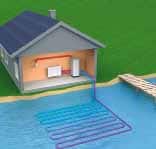
* The brine is a mixture that cannot freeze, for example alcohol or glycol.
** Modern environmentally sound refrigerants are used e.g. hydrocarbons and carbon dioxide.
Brine* circulates in a collector coil and draws low temperature energy from the ground, air, bedrock or water.
At the heat exchanger (evaporator) the tepid brine in the collector coil meets the ice-cold refrigerant** in the heat pump which is then heated a few degrees and converted to a gas.
In the compressor, the pressure is increased thereby raising the temperature of the refrigereant. The heat that is then generated is transferred via a heat exchanger (condenser) to your home’s heating system.
Via the condenser, the refrigerant releases the heat to the heating system of your home. In connection with this the refrigerant is cooled.
The refrigerant circulates and an expansion valve lowers the pressure and the refrigerant becomes cold again. The process begins again when the refrigerant meets the tepid brine from the collector coil.

Lake Water
With a lake water heat pump you retrieve the solar energy found in the lake water through a pipe that is lowered to the bottom of the lake watercourse where weights hold it in place. The principle is the same as for ground heat.
Advantages
- No drilling needed
- Little impact on your plot
- The lake coil holds an even temperature throughout the year

Groundwater
An open loop system collects energy from the groundwater. The water is pumped up from a groundwater bore hole to a heat exchanger, where the energy is recovered. The water is then discharged back downstream through another bore hole.
Advantages
- No great size of plot required
- Little impact on your plot
- The coil in the water maintains an even temperature throughout the year
Heat pumps are built around the fact that gas that is compressed gets hot and gas that expands cools.
Remember a bicycle pump that compresses air, creating heat.
